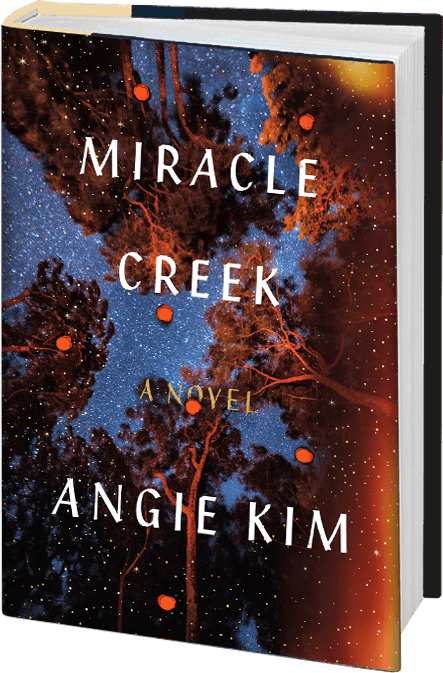
In Angie Kim’s debut novel Miracle Creek, the Yoo family run an alternative treatment facility where patients can enter the “miracle submarine,” a large oxygen chamber meant to treat conditions ranging from autism to infertility. When the submarine catches fire, patients are injured and killed, and the mother of one of the patients is prosecuted for murder. As witnesses appear before the court, the story weaves through the lives of the families affected by the tragedy.
Part courtroom procedural, part family drama, the book shifts perspective as the characters all tell their version of events. Yet the more we as readers discover about the day of the fire, the more we realize that each of our narrators seems to be hiding their own secrets. Miracle Creek, in the ways it addresses topics such as disability, reproductive science, and immigration, is both timely and entertaining. It also feels like a metaphor for the current moment, where the truth can feel elusive.
Kim spoke with The Rumpus about her creative process; about how her background as a former lawyer, mom, and Korean immigrant informed her writing. and about how we all find meaning and identity in the stories we construct about ourselves and our place in the world.
***
The Rumpus: The plot of Miracle Creek plays out in the form of a courtroom drama. What attracted to you to that format and setting?
Angie Kim: I used to be a trial lawyer, and I loved being in the courtroom and dealing with witnesses. Trying to figure out their motivations in saying what they said and, just as importantly, how they said it, the psychology of it. Cross-examining hostile witnesses was my absolute favorite. I also enjoyed telling the story, whether it be written (in briefs) or oral (such as opening statements).
I left the law to go into business and became an entrepreneur, but I really missed the courtroom aspect of practicing law. When I started thinking about this novel, it seemed natural to structure it around a murder trial, given my familiarity with courtroom procedures and my appreciation for the drama and surprising twists that setting can produce.
I had so much fun when I sat down to write the courtroom scenes. It felt almost like being back in court, except so much better because I could have the witnesses say what I wanted them to say—a litigator’s fantasy come true!
Rumpus: The novel explores questions of devotion to (and sacrifice for) children. We see that theme demonstrated by both Pak and Young Yoo, and by Elizabeth Ward. Can you talk a bit about what drew you to those questions of devotion and sacrifice?
Kim: Parental sacrifice at its extremes is something I’ve thought a lot about, both as a child and as a parent. I’m an only child, and my parents decided to move from Seoul, South Korea, to Baltimore, Maryland, when I was eleven, mainly for my future. When we got to America, they worked eighteen-hour days, seven days a week, at a bullet-proofed grocery store in a dangerous part of Baltimore where my father was shot. He narrowly escaped being killed, all so that I could get a good education and go to a good college.
I’m not sure that I fully appreciated the extent of their self-sacrifice—of the parental sacrifice inherent to immigration—until I was much older, but I remember witnessing their bewilderment and discomfort with the unfamiliar culture and language and feeling guilty that they’d put themselves in that position for me.
When I became a parent myself, I was determined to find more of a balance. But all three of my kids had medical scares and issues—ranging from hearing loss and celiac disease to anaphylaxis and suspected microcephaly—all different and mysterious, requiring a lot of testing and research and insurance filings and appeals. I found myself doing everything I’d vowed I wouldn’t do: becoming a stay-at-home mom, losing touch with my friends, never going out, spending all my waking moments focused on my kids. My kids are all fine now, and I’ve been able to regain my sense of self, as a person separate and apart from my identity as a mother, but I think this is a dynamic that many parents of children with medical/special needs experience, and I’ve been eager to explore that through essays and stories.
Rumpus: Many of the characters in Miracle Creek are struggling to find their place in their community in rural Virginia. We see this struggle in the Yoos, who are recent immigrants, in Matthew and Janine, who are dealing with infertility, and in Teresa, who is the mother to teenage girl with a serious disability. Why do you think belonging or a sense of community might be an important topic for this book?
Kim: I think being an immigrant during my pre-teen, middle school years affected me profoundly. As an immigrant, I left my native land behind, along with my group of close friends and family. I re-settled in a new country where I didn’t speak the language, didn’t understand the customs, didn’t wear the right clothes, and didn’t know anyone. It was unsettling, to say the least, and added to that, I was a racial minority and didn’t see many people who looked like me. I felt like an unwelcome foreigner, and I was desperate to find anyone who treated me like a friend.
Later, when I became a parent, I realized this same dynamic occurs with new parents, especially stay-at-home mothers who lose touch with every aspect of their former lives, including work. Most parents settle into a new community of parents of similarly aged children (playgroups and daycare/preschool), but when you have a child who is “different” in some way, that can lead to even more of a sense of isolation. Having gone through these experiences myself, I think I was able to recognize this would be a key struggle for the characters in my novel, and to infuse that sense into their stories.
Rumpus: How long did it take you to write the book? What was your process like?
Kim: I started with a kernel of an idea in early 2012—a hyperbaric oxygen chamber as a crucible, with special-needs children and their mothers sealed inside for a medical treatment, when something goes horribly wrong and some of them die and suffer serious injuries. I did a lot of free-writing by hand, and sketched out various characters, their relationships with each other, and their lives both prior to and after the incident.
In early 2013, I started to draft scenes on the computer and submit a few chapters at a time to my trusted writing group. I finished the first draft in 2015, two years after I started writing, then took a break and didn’t even think about it for six months.
I took another six months to revise it, incorporating the chapter-by-chapter feedback I’d gotten from my writing group, then submitted the whole novel to beta readers, including my writing group and close friends, and revised a second time based on their feedback.
That takes us to the fall of 2016, which is when I started to query agents. I signed with my agent in November 2016 (I was actually in New York City meeting with agents on Election Day!), and she suggested I add a few more POVs, so I wrote several more chapters.
Four months later, in March 2017, my novel was sold at auction, and my editor and I went through two more rounds of edits—one making some plot-oriented changes and one to tighten and shorten the manuscript. All in all, it took six years—one year of preparing and marinating, two years of drafting, then three years of revising!
Rumpus: The story starts and ends with a first-person narration by the character Young Yoo, but the rest of the novel is told in an alternating close third-person. How did you arrive at that choice for the narrative structure?
Kim: I knew I wanted the novel to be in close third-person, told from many of the major characters’ points of view. That way, I could delve into the intimate, personal experiences of multiple characters and have the narrative unfold slowly, bit by bit. But when I sat down to write the first scene, it came out in first person. There was something about the urgency of the night of the explosion, the frenetic sense of chaos in everything going wrong and Young unable to get a grip on the situation, that made a first-person narration the right choice.
Later, after the first draft was done, I tried rewriting the first scene in a third-person voice, to match the rest of the novel, but it felt wrong. I was able to justify it intellectually by telling myself that the first-person beginning made sense because it signaled to readers that Young Yoo is the main character and because it takes place at a different time than the rest of the novel. But if I’m being honest, it was less a “choice” and more just doing what (somewhat inexplicably) felt right.
***
Photograph of Angie Kim © Tim Coburn Photography.





